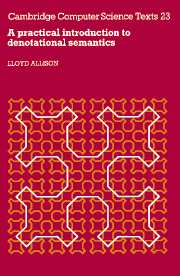5 results in Cambridge Computer Science Texts

A Practical Introduction to Denotational Semantics
-
- Published online:
- 05 June 2012
- Print publication:
- 30 January 1987

Concurrent Programming
-
- Published online:
- 05 June 2012
- Print publication:
- 20 February 1992

Program Construction
-
- Published online:
- 05 June 2012
- Print publication:
- 05 February 1987

Recursion via Pascal
-
- Published online:
- 05 February 2012
- Print publication:
- 26 July 1984

Categories and Computer Science
-
- Published online:
- 03 December 2009
- Print publication:
- 27 August 1992

